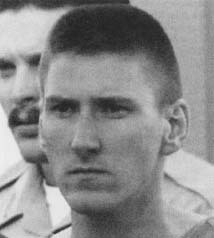Oklahoma City Bombing Trials: 1997-98
Mcveigh's Trial
Jury selection for McVeigh's trial began on March 31, 1997. When opening statements were made three weeks later, the prosecution charged that Mc-Veigh's hatred for the federal government had escalated into violence after the disastrous federal raid on the Branch Davidian religious compound near Waco, Texas, on April 19, 1993—two years to the day before the Oklahoma City bombing. In order to inspire an uprising against the government, McVeigh had parked a Ryder rental truck containing a 4,000-pound homemade bomb outside the Murrah Building in the erroneous belief that it was the headquarters of the agents who had carried out the Waco raid.
The prosecution couldn't produce an eyewitnesses placing McVeigh at the Murrah Building nor was there any direct evidence that he and Nichols had built the bomb. The key and rental paperwork for the Ryder truck had been recovered, but neither McVeigh's nor Nichols's fingerprints were found on them. The circumstantial evidence against McVeigh was stronger. Traces of PETN, a compound used in detonator cord, were found on his jeans, pockets, and a set of earplugs he was carrying when he was arrested. Phone records tied Mc-Veigh and Nichols to purchases of ingredients identical to those used in the bomb.
 Timothy McVeigh was executed by lethal injection for the Oklahoma city bombing that killed 168 people.
Timothy McVeigh was executed by lethal injection for the Oklahoma city bombing that killed 168 people.
Although the evidence was circumstantial, the prosecution's case was bolstered by abundant motive for McVeigh's alleged crimes. When he was arrested, antigovernment propaganda found in his car included an excerpt from The Turner Diaries, a white-supremacist novel containing an instructive chapter about blowing UP an FBI building with a bomb-laden truck. His sister Jennifer tearfully recalled McVeigh telling her that "something big" was going to happen in the spring of 1995. She also attributed a letter found in her computer to her brother. "You'll swing in the wind one day for your treasonous attacks against the Constitution of the United States," said the letter, which was written to the Bureau of Alcohol, Tobacco, & Firearms. "Die, you spineless cowardice bastards!"
Testifying under immunity, Lori Fortier recalled McVeigh's visits to the Fortiers' Arizona trailer during which he had described the process of building bombs, saying he intended to blow up a government building. She admitted that she and her husband had hidden and sold guns that McVeigh and Terry Nichols had stolen in Arkansas. She had made a fake identification card for McVeigh, using the name "Robert Kling"; a Ryder truck rental manager identified McVeigh as one "Robert Kling" who had rented the obliterated truck two days before the bombing.
Michael Fortier also recalled McVeigh's bomb-making experiments and testified that he had circled the Murrah Building with McVeigh in December 1994, during a trip to pick up the stolen guns in Kansas. McVeigh had detailed how he planned to blow up the building with a rental truck packed with explosives, hoping to cause a "general uprising in America." When Fortier commented on the potential loss of life, McVeigh allegedly replied that he "considered all those people to be as if they were storm troopers in the movie StarIVars. They might be individually innocent, but because they are part of the evil empire, they were guilty by association." Fortier admitted that he might have prevented the bombing by informing authorities.
McVeigh's defense attorneys did not offer an alibi for their client. Instead, they assailed the Fortiers' credibility, playing FBI wiretaps from the days after the bombing. "I can tell a fable, I can tell stories all day long," Michael Fortier was heard telling his brother. "The less I say now, the bigger the price later." Hoping to undercut the impact of his testimony, the defense portrayed Fortier as a methamphetamine addict and opportunist who was willing to lie to obtain lucrative book and film contracts about the case.
Suggesting that the real bomber might have died in the blast, the defense called a pathologist who testified that an unidentified leg found at the Murrah Building could have belonged to someone carrying a bomb. Scientist Frederic Whitehurst testified that the explosives residue on McVeigh's possessions had been examined during a period when FBI laboratory procedures were so flawed that they were later severely criticized by the Justice Department. Whitehurst admitted, however, that he had no specific knowledge that the evidence in the Oklahoma City cases had been tainted.
After almost two weeks of testimony, on June 2, the jury convicted Mc-Veigh on all 11 counts. During the subsequent penalty phase of the trial, the jury unanimously agreed that McVeigh's actions were distinguished by aggravating factors such as premeditation and intent to kill and consequently recommended a death sentence on June 13. On August 14, Judge Matsch formally sentenced McVeigh to be executed by lethal injection. But it wasn't until June 11, 2001 that this execution finally took place in Terre Haute, Indiana.
Additional topics
- Oklahoma City Bombing Trials: 1997-98 - Nichols's Trial
- Oklahoma City Bombing Trials: 1997-98 - Oklahoma Grand Jury, Colorado Venue
- Other Free Encyclopedias
Law Library - American Law and Legal InformationNotable Trials and Court Cases - 1995 to PresentOklahoma City Bombing Trials: 1997-98 - Oklahoma Grand Jury, Colorado Venue, Mcveigh's Trial, Nichols's Trial, Mixed Verdict